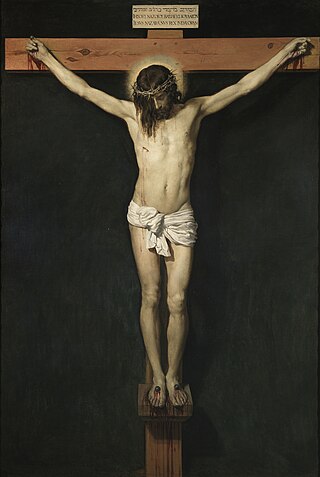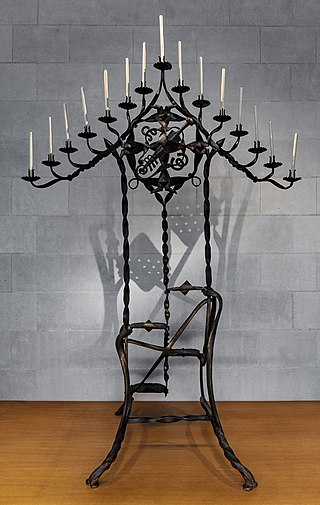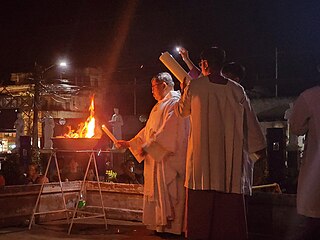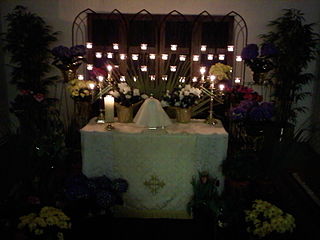
Easter fires, also called Paschal fires, [1] are typically bonfires lit at Easter as part of liturgical and cultural celebrations.

Easter fires, also called Paschal fires, [1] are typically bonfires lit at Easter as part of liturgical and cultural celebrations.
Used in solemn Roman Catholic, Lutheran, Reformed, Anglican, and Methodist celebrations of the Easter Vigil held after sunset on Holy Saturday, concluding the Paschal Triduum. Such a fire might be used to light a Paschal candle or other candles used symbolically before or during Mass or other religious celebration. [2] [3] [4]
As a sacrament in remembrance of the Resurrection of Jesus, the Catholic Mass according to Roman rite begins with a big celebration of light (Lucernarium): an open fire is lighted outside the church and blessed by the priest; when the Paschal candle is lit, the community ceremoniously enters the dark church chanting Lumen Christi and Deo gratias .
The Easter Vigil liturgies of the Roman Catholic, Lutheran, Anglican, Methodist and Presbyterian Churches are nearly identical. [5]
According to the Eastern Orthodox tradition of the Holy Fire, worshippers light candles from the Paschal trikirion during service at Saturday Midnight, while the troparion is sung.
Though not documented before the 16th century, the custom presumably is based on Saxon, pre-Christian traditions, that are still performed each year. There are several explanations of the meaning of these fires. The Saxons probably believed that around the time of Easter, Spring becomes victorious over Winter. The fires were supposed to help chase the darkness and winter away. It was also a symbol of fertility, which works in a literal sense in that the ashes were scattered over the meadows and thereby fertilized the soil.[ citation needed ] Another possible origin of the Easter fire is that of St. Patrick lighting an unquenchable "High King" fire in defiance of the throne on the night before Easter of 432AD. The fire is symbolic of the undimmed light of Christ despite the pagan government's attempts to put it out and marked the beginning of the conversion of Ireland to Christianity. This fire reminds Christianity of the Eternal High Kingship of Christ. [6] [ unreliable source? ]
In Northern Germany, Easter Fires (German : Osterfeuer) are lit around sunset on Holy Saturday.
In some Old Bavarian regions, the Burning of Judas on Holy Saturday is still common.

Easter fires also exist in the Netherlands.
In Fredericksburg, Texas, each year the residents have Easter Fires the night before Easter, commemorating a peace treaty with the Comanche Indians. In 1847 when the original treaty was signed, the Comanches lit signal fires on the area hills. [7]
Amongst South Slavs (Serbs, Montenegrins, Slovenes, Croats, Bulgarians, Macedonians, Bunjevci and Šokci), it is required to jump over the flames of Easter (Serbian Cyrillic : Крљавештице, romanized: Krljaveštice). [8]

Easter, also called Pascha or Resurrection Sunday, is a Christian festival and cultural holiday commemorating the resurrection of Jesus from the dead, described in the New Testament as having occurred on the third day of his burial following his crucifixion by the Romans at Calvary c. 30 AD. It is the culmination of the Passion of Jesus Christ, preceded by Lent, a 40-day period of fasting, prayer, and penance.

The liturgical year, also called the church year, Christian year or kalendar, consists of the cycle of liturgical seasons in Christian churches that determines when feast days, including celebrations of saints, are to be observed, and which portions of Scripture are to be read either in an annual cycle or in a cycle of several years.

A Paschal candle is a large, white candle used in liturgies in Western Christianity. A new Paschal candle is blessed and lit every year at Easter, and is used throughout the Paschal season which is during Easter and then throughout the year on special occasions, such as baptisms and funerals.

Good Friday is a Christian holy day observing the crucifixion of Jesus and his death at Calvary. It is observed during Holy Week as part of the Paschal Triduum. It is also known as Black Friday, Holy Friday, Great Friday, Good Friday of the Passion of the Lord,Great and Holy Friday.

Liturgical colours are specific colours used for vestments and hangings within the context of Christian liturgy. The symbolism of violet, blue, white, green, red, gold, black, rose and other colours may serve to underline moods appropriate to a season of the liturgical year or may highlight a special occasion.
Maundy Thursday or Holy Thursday, among other names, is the day during Holy Week that commemorates the Washing of the Feet (Maundy) and Last Supper of Jesus Christ with the Apostles, as described in the canonical gospels.

Holy Week is the most sacred week in the liturgical year in Christianity. For all Christian traditions, it is a moveable observance. In Eastern Christianity, which also calls it Great Week, it is the week following Great Lent and Lazarus Saturday, starting on the evening of Palm Sunday and concluding on the evening of Great Saturday. In Western Christianity, Holy Week is the sixth and last week of Lent, beginning with Palm Sunday and concluding on Holy Saturday.

Holy Saturday, also known as Great and Holy Saturday, Low Saturday, the Great Sabbath, Hallelujah Saturday, Saturday of the Glory, Sábado de Gloria, and Black Saturday or Easter Eve, and called "Joyous Saturday", "the Saturday of Light", and "Mega Sabbatun" among Coptic Christians, is the final day of Holy Week, between Good Friday and Easter Sunday, when Christians prepare for the latter.

The Paschal Triduum or Easter Triduum, Holy Triduum, or the Three Days, is the period of three days that begins with the liturgy on the evening of Maundy Thursday, reaches its high point in the Easter Vigil, and closes with evening prayer on Easter Sunday. It is a moveable observance recalling the Passion, Crucifixion, Death, burial, and Resurrection of Jesus, as portrayed in the canonical Gospels.

Tenebrae is a religious service of Western Christianity held during the three days preceding Easter Day, and characterized by gradual extinguishing of candles, and by a "strepitus" or "loud noise" taking place in total darkness near the end of the service.
Christian liturgy is a pattern for worship used by a Christian congregation or denomination on a regular basis. The term liturgy comes from Greek and means "public work". Within Christianity, liturgies descending from the same region, denomination, or culture are described as ritual families.

The Easter Vigil, also called the Paschal Vigil, the Great Vigil of Easter, or Holy Saturday in the Easter Vigil on the Holy Night of Easter is a liturgy held in traditional Christian churches as the first official celebration of the Resurrection of Jesus. Historically, it is during this liturgy that people are baptized and that adult catechumens are received into full communion with the Church. It is held in the hours of darkness between sunset on Holy Saturday and sunrise on Easter Day – most commonly in the evening of Holy Saturday or midnight – and is the first celebration of Easter, days traditionally being considered to begin at sunset.

The Exsultet, also known as the Easter Proclamation, is a lengthy sung proclamation delivered before the paschal candle, ideally by a deacon, during the Easter Vigil in the Roman Rite of Mass. In the absence of a deacon, it may be sung by a priest or by a cantor. It is sung after a procession with the paschal candle before the beginning of the Liturgy of the Word. It is also used in Anglican and various Lutheran churches, as well as other Western Christian denominations.

In the Roman Rite of the Catholic Church, Lutheranism, Methodism and Anglicanism, an altar bell is typically a small hand-held bell or set of bells. The primary reason for the use of such bells is to create a “joyful noise to the Lord” as a way to give thanks for the miracle taking place atop the altar.

The ceremonial use of lights occurs in liturgies of various Christian Churches, as well as in Jewish, Zoroastrian, and Hindu rites and customs.

The altar of repose is a temporary altar where the Communion hosts consecrated on Maundy Thursday during the Mass of the Lord's Supper are placed, or "reserved", for use on the following day, Good Friday.

The Mass of the Lord's Supper, also known as A Service of Worship for Maundy Thursday, is a Holy Week service celebrated on the evening of Maundy Thursday. It inaugurates the Easter Triduum, and commemorates the Last Supper of Jesus with his disciples, more explicitly than other celebrations of the Mass.

Lumen Christi is a versicle sung in Catholic, Lutheran and some Anglican churches as part of the Easter Vigil. In Lutheran and Anglican services, it is sung in the local language. It is chanted by the deacon on Holy Saturday as he lights the candle. In the English Sarum Rite, one candle is lit.

Lent is the solemn Christian religious observance in the liturgical year commemorating the 40 days Jesus spent fasting in the desert and enduring temptation by Satan, according to the Gospels of Matthew, Mark and Luke, before beginning his public ministry. Lent is usually observed in the Catholic, Lutheran, Moravian, Anglican, United Protestant and Orthodox Christian traditions, among others. Some Anabaptist, Baptist, Methodist, Reformed, and nondenominational Christian churches also observe Lent, although many churches in these traditions do not.

The Stripping of the Altar or the Stripping of the Chancel is a ceremony carried out in many Catholic, Lutheran, Methodist, and Anglican churches on Maundy Thursday.
Many Christians are already familiar with the ancient, and now recently restored, liturgies of the Three Days: Maundy Thursday, Good Friday, and the great Easter Vigil service of light, readings, baptism, and communion. The worship resources published by the Evangelical Lutheran Church in America, the Episcopal Church, the United Methodist Church, the Presbyterian Church U.S.A. and the Catholic Church include nearly identical versions of these liturgies.